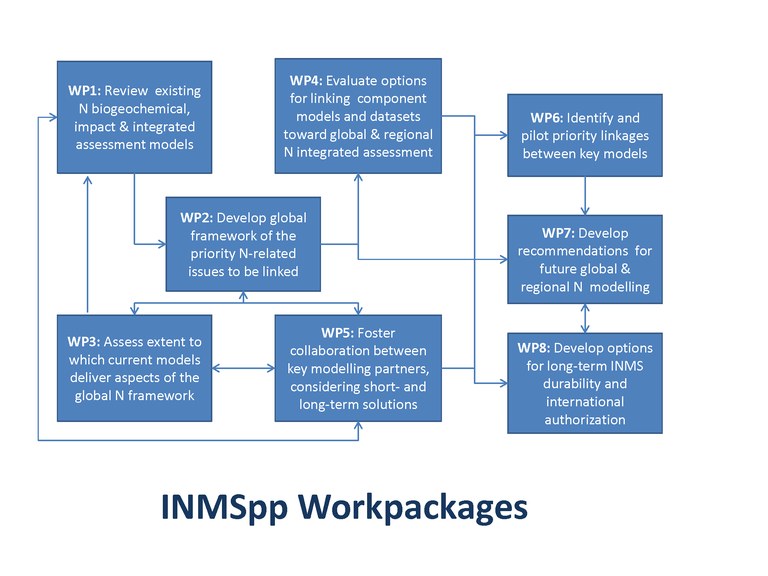INMSpp Project Information
This page provides information on the INMS Pump Priming (INMSpp) project, funded by the International Opportunities Fund of the UK Natural Environment Research Council (NERC).
Project Outline
The overall goal of INMSpp is to establish a framework for the international model chain that will be needed for the International Nitrogen Management System. The focus starts from the needs of international conventions and policy makers to demonstrate how feasible improvements in global and regional nitrogen management would translate into quantified co-benefits (expressed as improved food and energy security, reduced pollution and climate threats and in net economic terms). The overall goal therefore focuses on developing the global capability for nitrogen integrated assessment modelling, linking air, land, water, food, energy and other nitrogen-related issues. It is a three year project which began in 2014.
The first workshop of the project was held in May 2015, in Edinburgh, just prior to a meeting of the Task Force on Integrated Assessment Modelling (TFIAM), of the United Nations Economic Commission for Europe (UNECE), Convention on Long Range Transboundary Air Pollution (CLRTAP). Information on the meeting, including how to register, can be found here.
Specific Objectives
The project has 8 Specific Objectives, which correspond to 8 Workpackages:
WP1. To review existing biogeochemical, impact and integrated assessment models relevant for different aspects of global nitrogen flows, benefits/threats and cost-benefit analysis at regional and global scales, including their suitability for addressing a range of regionally specific mitigation and adaptation options.
WP3. To assess the extent to which current component models can deliver aspects of the global nitrogen framework, identifying the key gaps between different domains (air, land, water, food, energy etc) and the available models.
WP4. To evaluate and summarize the options for linking models and datasets towards an implementation of the global nitrogen framework for integrated assessment of nitrogen benefits and threats.
WP5. To foster collaboration between key modelling partners, drawing on both UK National Capability and international expertise, towards the development of joined up nitrogen modelling solutions, including both (simpler) short-term options and (preferable) longer-term solutions that require further development.
WP6. To identify and pilot a short-list of priority linkages for development in cooperation with key partners.
WP7. To feed the outcomes into developing a set of recommendations for future development of integrated global modelling of nitrogen, that can be used for long-term development of the INMS and inform the development of future UK and international research strategies.
WP8. To examine and further develop the options for long-term durability and authorization of the eventual INMS system, in relation to future financing mechanisms, including through UK National Capability, the Global Environment Facility (GEF), UNEP and other European and international mechanisms.
The overall linkages between these workpackages is shown in the figure below.

Project Implementation
A number of workshops are planned during the project, to engage with the Integrated Assessment Modelling community, the first of these (which will address objectives 1 & 2) was held in May 2015, in Edinburgh. Please visit this link for further details of this meeting.



 GEF IW:LEARN
GEF IW:LEARN


